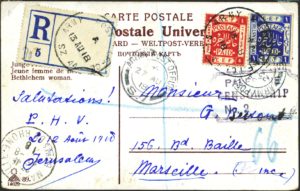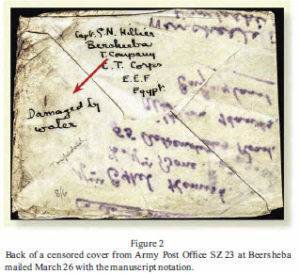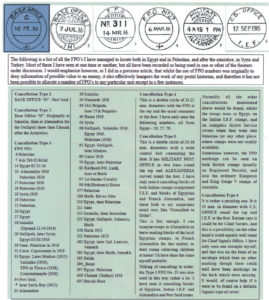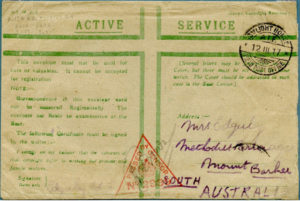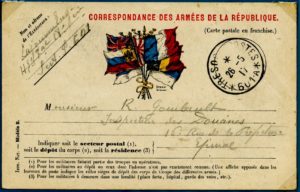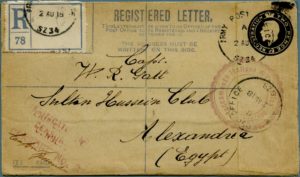World War I
Our Focus is Only on the Holyland (Palestine)
Postal Offices
Foreign Military
♦Allies Powers
ALLIES
British
In November 1917, the British Egyptian Expeditionary Force occupied Palestine. Initially, the Egyptian Expeditionary Force (and the Indian Expeditionary Force) had given civilians basic postal services for free, with additional services paid in British or Indian stamps. Free mail was withdrawn with the printing of appropriate stamps. Two stamps inscribed E.E.F. (1 Piastre, and 5 Millièmes) were issued in February 1918, the first definitives (11 values) were circulated from June 1918. These E.E.F. stamps were valid in Palestine, Cilicia,[78] Syria, Lebanon, and Transjordan. Prior to the British Mandate in Palestine, Hebrew was not an official language, and so these stamps bore only Arabic inscriptions besides English.
Retrieved from “https://en.wikipedia.org/w/index.php?title=Postage_stamps_and_postal_history_of_Palestine&oldid=822427570” This page was last edited on 26 January 2018, at 09:15. Text is available under the Creative Commons Attribution-ShareAlike License; additional terms may apply.
ALLIES
British
World War I Allies Powers British Army Post
Registered postcard from Jerusalem to Marseille 1918
Date
13/8/1918
Place of Origin
Jerusalem
Place of destination
Marseille
Object Type
Picture Postcard
Reg.Number
MHDA.1090.2012
http://alexandercollection.org/collectionitem.
aspx#collection=182&item=877073901&startitem=12
ALLIES
British
. . . . . .
the sinking of the Kingstonian, one of the most intriguing, complex and controversial aspects of World War I Palestine postal history.
. . . . . .
In addition, clearly water-damaged mail from Palestine and Egypt, in the correct time period, is known with only a manuscript “damaged by water” notation. Figure 2 is the back of a censored cover from Army Post Office SZ 23 at Beersheba mailed March 26 with the manuscript notation. A washed out triangular censor mark and the FPO cancel are on the front.
The 1918 Sinking of the Kingston. Israel Philatelist, Fall 2016, pp. 38 -40.
ALLIES
British
(Indian and Australia/New Zealand)
ALLIES
British
(Indian)
The advance into what was Turkish held Palestine began on January 9th, 1917. At the start of the campaign, there were relatively few Indian troops involved.
. . . . . The organization of the Post Office altered from serving a predominately static force, to one which was on the move,
. . . . . Following the third and decisive Battle of Gaza, the Railhead P.O. moved to Dier Sneid. Following the capture of Jerusalem and Jaffa, FPOs were opened in both towns, and the Railhead moved to Ludd. During 1918, more and more Indian troops poured into the theatre . . . .
Indian Expeditionary Force “E” and “F”. The Israel Philatelist, Winter 2016, pp. 37 -39
See box below for 6 different FPO cancellations, and additional information.
Please note “Cancellation Type 2”. There are listed FPO NOs and there locations and year in Palestine.
ALLIES
British
(Australia/New Zealand)
Australia and New Zealand fought in Palestine, starting in 1917.
Active service cover from Gaza front to Australia 1917
Date
12/3/1917
Place of Origin
Gaza
Place of destination
Australia
Reg.Number
MHDA.1066.2012
http://www.alexandercollection.org/collectionitem.
aspx#collection=183&item=520727583&startitem=1
ALLIES
Detachments
(French and Italian)
ALLIES
Detachment
(French)
Military postcard of the French Detachment from Gaza to France 1917
Date
26/5/1917
Place of Origin
Gaza
Place of destination
France
Reg.Number
MHDA.1055.2012
http://www.alexandercollection.org/collectionitem.
aspx#collection=179&item=180966288&startitem=1
At a British-French Conference on December 28, 1916, it was agreed that a French contingent would join the Egyptian Expeditionary Force. On May 25, 1917, the D.F.P. (Détachement Français de Palestine) comprising a territorial battalion, two battalions of native riflemen, a reinforced case-shot company and a sapper company, were transported by railway to Khan Yunis. The main duties of this composite force was the surveillance of communication lines at the front line.
The French Government wished to see the D.F.P. nearer to the front, and because of this the main bulk of the French Troops was transferred to Junction Station and Ramleh. Secondary units occupied garrisons at Jerusalem, Jaffa, Gaza, and Nahr Soukereir.
The D.F.P. participated in the offensive of September 19, 1918, seizing the village of Tulkarm and taking part in the capture of Nablus. A mixed squadron of the D.F.P.S. took part in the entry into Damascus of allied troops on October 2, 1918.
The French detachment maintained its own postal services in Palestine. In March 1917 it was estimated that Field Post Office 601 could service the mail for the Port Said base, Mission “B” at Suez, and the French Palestine Detachment. It quickly became obvious that another Field Post Office was needed, and F.P.O. 601A was established to serve the forward troops. In July 1918 F.P.O. 601B, which had been created in October 1917 to service the Eastern Legion stationed in Cyprus, was transferred to Palestine, at the same time as the Eastern Legion was transferred there. F.P.O. 601B served the advance base at Lydda.
http://alexandercollection.org/collectionitem.
aspx#collection=179&overview=1
ALLIES
Detachment
(Italian)
2-8-1918 Reg Army letter of the Italian Detachment from Jaffa to Alexandria 1918
Registered Army letter of the Italian Detachment from Jaffa to Alexandria 1918
Date
2/8/1918
Place of Origin
Jaffa
Place of destination
Alexandria
Reg.Number
MHDA.1043.2012
http://alexandercollection.org/collectionitem.
aspx#collection=178&item=1321231410&startitem=1
Among the Allies who participated in the Holy Land campaign against the Turks during World War I were a certain number of Italian troops, who left Italy in May 1917 and served until September 1919.
They were integrated with the troops of General Allenby, maintaining their own headquarters at Tel Aviv. After taking part in the campaign which resulted in the surrender of Jerusalem on December 9, 1917, they remained and participated in other campaigns, particularly in the mopping-up operations of September 1918. The Italians were repatriated during September 1919. The Italian detachment had no postal system of its own, but shar¬ed the British post office facilities. The Italians used a single circular cancel reading Army Post Office; FPOs serving the Italians were S. Z. 34, S. Z. 47 and Base A.P.O. T. In addition, the Italians applied their own cachets and markings to their correspondence. Known markings are the large coat of arms of the royal House of Savoy within a double circle, surrounded by the words “Guardia Italiana Gerusalemme”, a smaller coat of arms and the words “Distaccamento Italiano di Palestino – Commando,” and a larger coat of arms with the same wording.
http://alexandercollection.org/collectionitem.
aspx#collection=178&overview=1
Below from Wikipedia
. . . . . . . The Palestine campaign began early in 1917 with active operations resulting in the capture of Ottoman Empire territory stretching 370 miles (600 km) to the north, being fought continuously from the end of October to the end of December 1917.
. . . . . . . When the possibility of a British invasion of Palestine was first raised, it became necessary to reach an understanding with France, which also had an interest in Palestine and Syria. . . . that Britain would occupy Palestine and France would occupy Syria. They also agreed that an all-arms French contingent would be attached to the Egyptian Expeditionary Force.
. . . . . . . after the war. On 9 April 1917 Italy’s ambassador in London, Guglielmo Imperiali, finally received approval to send no more than “some three hundred men … for representative purposes only” to Palestine. In the end, 500 infantry were sent. This included some Bersaglieri, whose famous capercaillie feathers are visible in photographs from the fall of Jerusalem. Their “mainly political” role was to assert “hereditary ecclesiastical prerogatives in connection with the Christian churches at Jerusalem and Bethlehem”.
“https://en.wikipedia.org/w/index.php?title=Sinai_and_Palestine_Campaign&oldid=811491423” This page was last edited on 21 November 2017, at 23:52. Text is available under the Creative Commons Attribution-ShareAlike License; additional terms may apply.

